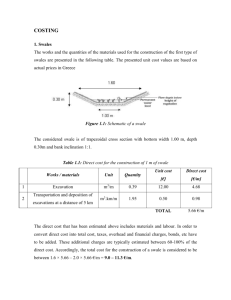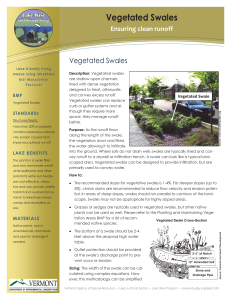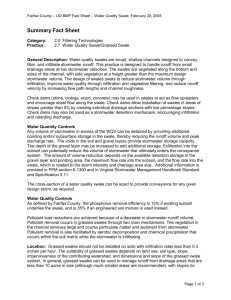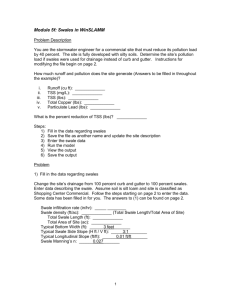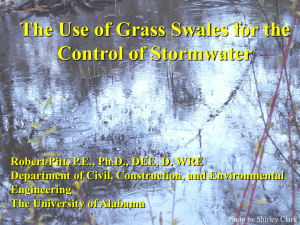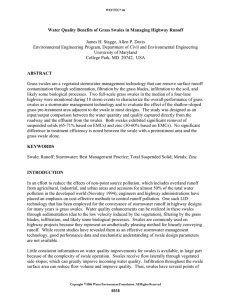General Information
advertisement
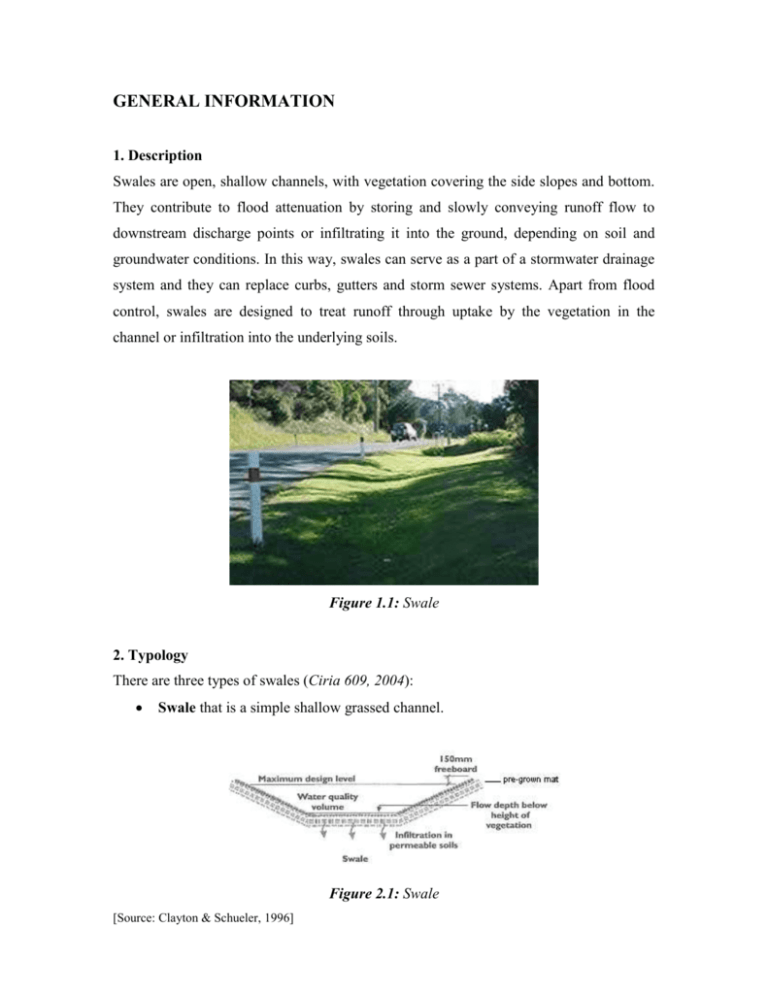
GENERAL INFORMATION 1. Description Swales are open, shallow channels, with vegetation covering the side slopes and bottom. They contribute to flood attenuation by storing and slowly conveying runoff flow to downstream discharge points or infiltrating it into the ground, depending on soil and groundwater conditions. In this way, swales can serve as a part of a stormwater drainage system and they can replace curbs, gutters and storm sewer systems. Apart from flood control, swales are designed to treat runoff through uptake by the vegetation in the channel or infiltration into the underlying soils. Figure 1.1: Swale 2. Typology There are three types of swales (Ciria 609, 2004): Swale that is a simple shallow grassed channel. Figure 2.1: Swale [Source: Clayton & Schueler, 1996] Enhanced dry swale (or trough-trench) that is kept dry most of the time equipped with a filter layer of soil over an underdrain. The bottom of the swale should be at least 1 m above groundwater in order to prevent the swale bottom from remaining moist. This type is the preferred option in most locations, as it does not become unsightly or generate odours. Figure 2.2: Enhanced dry swale (or trough-trench) [Source: Clayton & Schueler, 1996] Wet swale that acts as a linear wetland because of the standing water that is retained in the channel. A wet swale occurs when the water table is located very close to the surface. Because of its boggy appearance, wet swale may be unsuitable for residential settings. Figure 2.3: Wet swale [Source: Clayton & Schueler, 1996] 3. Suitable applications – advantages and disadvantages 3.1. Suitable applications: Swales can be best applied in residential, industrial and commercial areas, as well as in car parks. They are generally used for subcatchments with small impermeable areas. The maximum impermeable catchment, for which swales are practical is between 2 ha and 4 ha (Ciria 609, 2004). 3.2. Advantages: Swales are able to control peak discharges by reducing runoff velocity and promoting infiltration, where ground conditions are suitable. They also provide water quality treatment by sedimentation and biological uptake, and they provide aesthetic value and wildlife habitat due to vegetation (Chester County Stormwater BMP Tour Guide, 2002). Additionally, swales offer lower capital costs than traditional storm sewer systems, and they can even replace curbs and gutters. 3.3. Disadvantages: Swales are vulnerable to large storms, because high-velocity flows can erode the vegetated cover (EPA, 1999). They are impractical in areas with very flat grades, steep topography, or where groundwater is very close to surface (Ciria C609, 2004) and they require more maintenance than curb and gutter systems. There may not be available land for them, especially in high-density developments with little landscaping. Standing water in vegetated swales can result in potential safety, odour and mosquito problems (EPA, 1999). 4. Performance 4.1. Pollutant removal: Pollutants, such as suspended solids, metals and hydrocarbons, are removed from surface flow by the filtering action of the grass, sediment deposition and infiltration into the soil. Swales are less successful in removing nutrients and do not remove bacteria. The efficiency of swales in removing pollutants is dependent on the quality of flow, the slope of the swale, the density and height of the grass and the permeability of the underlying soil. Swale length and water depth are significant factors that affect pollutant removal. Increase of the distance water travels along a swale, by increasing the swale length, improves mainly the removal of suspended solids. However, increase of water depth results in less effective removal of suspended solids, because the water flows over the vegetation rather than being filtered through it. (Ciria C609, 2004) Residence time is also crucial to pollutant removal efficiency. If residence time is greater than 9 minutes the TSS removal will be greater than 83%. (Walsh et al, 1997) 4.2. Flood control: Swales contribute to flood control through temporary storage and infiltration. Usually, they are designed to face events with recurrence interval T between 2 and 10 years. They can be linked to the sewer system through an overflow for events of lower frequency. 5. Design criteria 5.1. Soil and groundwater requirements: Swales should not be constructed in gravely and coarse sandy soils that cannot easily support dense vegetation (EPA, 1999). Soil infiltration rates should not be greater than 3.5 × 10-6 m/s, if infiltration is required (Revitt, Ellis and Scholes, 2003). Restrictions on the depth to groundwater depend on the type of the swale used. Generally, groundwater should be at least 0.6 m below the bottom of the swale (Revitt, Ellis and Scholes, 2003). 5.2. Hydraulic design: Typically, a swale accommodates runoff from a two-year storm to flow through without causing erosion, but it should have the capacity to handle larger flows (usually a ten-year storm). Swales should generally treat small drainage areas (less than 2 ha). If they are used to treat larger areas, the stormwater flow velocity through the system becomes too great to treat runoff or prevent erosion. Generally, swales operate efficiently when maximum flow rates do not exceed 0.5 m/s. Swales should be used on sites with relatively flat slopes (less than 10%). Runoff velocities within channels often become too fast on steeper slopes, which can cause erosion and prevent adequate infiltration. Apart from flat side slopes, swales should have a trapezoidal or parabolic cross section. This maximises the wetted perimeter (the length along the edge of the channel cross-section that is in contact with the runoff) and thus enhances treatment. A pre-treatment may be provided to protect the filtering and infiltration capacity of the swale bed by trapping incoming sediments. Pre-treatment can occur in a sediment forebay behind a check dam with a pipe inlet. (Minnesota Urban Small Sites BMP Manual, 2001) The flat channel bottom should be between 0.50 and 2.50 m wide, the minimum to ensure sufficient filtering surface for water quality treatment, the maximum to minimise the likelihood of flow channelization within a portion of the swale bottom. (Minnesota Urban Small Sites BMP Manual, 2001) 5.3. Erosion – Extreme events: To prevent erosion, flow velocities must be kept below a critical value for runoff that is greater than the water quality treatment volume. The critical velocity at which erosion occurs depends on the soil and vegetation type. (Ciria C609, 2004) Table 5.3.1: Maximum allowable flow velocities based on soil type Soil type Maximum allowable velocity m/s Seeded Turfed Sand 0.6 0.91 Silt loam, sandy loam, loamy sand 0.6 0.91 Silty clay loam, sandy clay loam 0.76 1.2 Clay, clay loam, sandy clay, silty clay 0.91 1.5 [Source: New Jersey Department of Environmental Protection, 2000] Typically, swales cannot provide storage for events greater than a 1 in 10-year return period, even for small catchments. This is the reason they are often used in conjunction with other BMP techniques to provide the required runoff control. (Ciria C609, 2004) 5.4. Planting: A fine, close-growing, water-resistant grass should be selected for use in swales, because increasing the surface area of the vegetation exposed to the runoff improves the effectiveness of the swale system. (EPA, 1999) Appropriate soil stabilization methods, such as mulch, blankets or mats should be used before establishment of vegetation. (Minnesota Urban Small Sites BMP Manual, 2001) 6. Operation and maintenance The useful life of a swale is directly proportional to its maintenance frequency. If properly designed and regularly maintained, swales can last indefinitely. (EPA, 1999) Usually, swales require little more than normal landscape maintenance activities such as irrigation and mowing to maintain pollutant removal efficiency (California Stormwater BMP Handbook, 2003). Higher runoff velocities increase the frequency of required maintenance. Swales can become a nuisance due to mosquito breeding in standing water if obstructions develop (e.g., debris accumulation, invasive vegetation) or if proper drainage slopes are not implemented and maintained. The application of fertilizers and pesticides should be minimized (California Stormwater BMP Handbook, 2003). Swales should be designed for a maximum residence time of 24 hours. This will eliminate mosquito problems since mosquitoes generally require 48 hours to breed and hatch. A recommended inspection and maintenance schedule for swales is provided below (Table 6.1): : Table 6.1: Recommended inspection and maintenance schedule [Source: California Stormwater BMP Handbook, 2003] REFERENCES California Stormwater Quality Association (2003). California Stormwater BMP Handbook: New development and redevelopment. TC-30. Chester County Conservation District (2002). Chester County Stormwater BMP Tour Guide. CIRIA (2004). Sustainable drainage systems: Hydraulic, structural and water quality advice. Report C609, Construction Industry Research & Information Association, London. Clayton R.A., Schueler T.R. (1996). Design of stormwater filtering systems. Centre for Watershed Protection, Maryland. Minnesota Metropolitan Council (2001). Minnesota urban small sites BMP manual. Prepared by Barr Engineering for Minnesota Metropolitan Council, Environmental Services, St Paul. New Jersey Department of Environmental Protection (2000). Manual for New Jersey: Best management practices for control of nonpoint source pollution from stormwaters. New Jersey Department of Environmental Protection, Trenton, NJ. Revitt D.M., Ellis J.B., and Scholes L. (2003). Report 5.1. Review of the use of stormwater BMPs in Europe. DayWater Project. Middlesex University. United States Environmental Protection Agency (1999). Stormwater Technology Factsheet: Vegetated swales. EPA 832-F-99-006, US EPA, Office of Water, Washington DC. Walsh P.M., Barrett M.E., Malina J.F., and Charbeneau R.J. (1997). Use of vegetative controls for treatment of highway runoff. Centre of Engineering Research in Water Resources, Bureau of Engineering Research, University of Texas at Austin.
